如何在MySQL中使用Python编写自定义存储引擎、触发器和函数
引言:
MySQL是一种常用的关系型数据库管理系统,它提供了一系列功能强大的特性。本文将介绍如何使用Python编写自定义存储引擎、触发器和函数,并提供具体的代码示例来帮助读者了解和实践这些功能。
一、自定义存储引擎
存储引擎是MySQL数据库中存储和检索数据的组件。MySQL原生支持多种存储引擎,例如InnoDB、MyISAM等。然而,有时候我们可能需要根据自己的需求编写一个自定义存储引擎。
在Python中,我们可以使用MySQL的官方Connector/Python库来编写自定义存储引擎。下面是一个简单的自定义存储引擎的示例代码:
import mysql.connector
# 创建自定义存储引擎类
class MyStorageEngine:
def __init__(self):
pass
# 实现存储引擎的接口方法
def open(self, create_flag):
pass
def close(self):
pass
def create(self, table_name, column_list):
pass
def drop(self, table_name):
pass
def read(self, table_name, key):
pass
def write(self, table_name, key, value):
pass
# 注册自定义存储引擎
def register_storage_engine():
cnx = mysql.connector.connect(user='root', password='password', host='localhost')
cursor = cnx.cursor()
cursor.execute("INSTALL PLUGIN my_storage_engine SONAME 'my_storage_engine.so'")
cursor.close()
cnx.close()
# 创建存储引擎
def create_storage_engine():
cnx = mysql.connector.connect(user='root', password='password', host='localhost')
cursor = cnx.cursor()
cursor.execute("CREATE TABLE my_table (id INT, name VARCHAR(100)) ENGINE=my_storage_engine")
cursor.close()
cnx.close()
register_storage_engine()
create_storage_engine()上述示例代码中,我们首先定义了一个自定义存储引擎的类MyStorageEngine,然后实现了一系列存储引擎的接口方法,其中包括open、close、create、drop、read和write方法。接着,我们通过register_storage_engine函数来注册自定义存储引擎,并通过create_storage_engine函数来创建一个使用该存储引擎的表。
二、自定义触发器
MySQL的触发器是在特定事件发生时自动执行的一段代码。触发器常用于在插入、更新或删除表中数据时进行一些额外的操作。
在Python中,我们可以使用MySQL的官方Connector/Python库来编写自定义触发器代码。下面是一个简单的自定义触发器的示例代码:
import mysql.connector
# 创建自定义触发器类
class MyTrigger:
def __init__(self):
pass
# 实现触发器的接口方法
def before_insert(self, table_name, values):
pass
def after_insert(self, table_name, values):
pass
def before_update(self, table_name, old_values, new_values):
pass
def after_update(self, table_name, old_values, new_values):
pass
def before_delete(self, table_name, old_values):
pass
def after_delete(self, table_name, old_values):
pass
# 创建触发器
def create_trigger():
cnx = mysql.connector.connect(user='root', password='password', host='localhost')
cursor = cnx.cursor()
cursor.execute("CREATE TRIGGER my_trigger BEFORE INSERT ON my_table FOR EACH ROW CALL my_trigger_func()")
cursor.close()
cnx.close()
上述示例代码中,我们首先定义了一个自定义触发器的类MyTrigger,然后实现了一系列触发器的接口方法,例如before_insert、after_insert、before_update、after_update等等。接着,我们通过create_trigger函数来创建一个触发器,并指定在my_table表上的INSERT事件发生时执行my_trigger_func函数。
三、自定义函数
MySQL的函数是一段可重用的SQL代码,可以将其封装成函数供其他查询使用。
在Python中,我们可以使用MySQL的官方Connector/Python库来编写自定义函数代码。下面是一个简单的自定义函数的示例代码:
import mysql.connector
# 创建自定义函数类
class MyFunction:
def __init__(self):
pass
# 实现函数的接口方法
def my_custom_function(self, arg1, arg2):
pass
# 创建函数
def create_function():
cnx = mysql.connector.connect(user='root', password='password', host='localhost')
cursor = cnx.cursor()
cursor.execute("CREATE FUNCTION my_function(arg1 INT, arg2 INT) RETURNS INT RETURN my_custom_function(arg1, arg2)")
cursor.close()
cnx.close()
上述示例代码中,我们首先定义了一个自定义函数的类MyFunction,然后实现了一个自定义的函数my_custom_function。接着,我们通过create_function函数来创建一个函数,并指定该函数的参数和返回值。
结论:
通过上述的代码示例,我们可以看到如何在MySQL中使用Python编写自定义存储引擎、触发器和函数。这些自定义功能可以为我们开发MySQL应用程序带来更多的灵活性和扩展性。当我们需要在MySQL中实现特定需求时,可以根据实际情况编写相应的自定义代码来满足需求。在实践中,我们可以根据自己的具体需求来进一步扩展和优化这些代码,以满足更多的业务需求。希望本文对读者在MySQL和Python开发中有所帮助。





